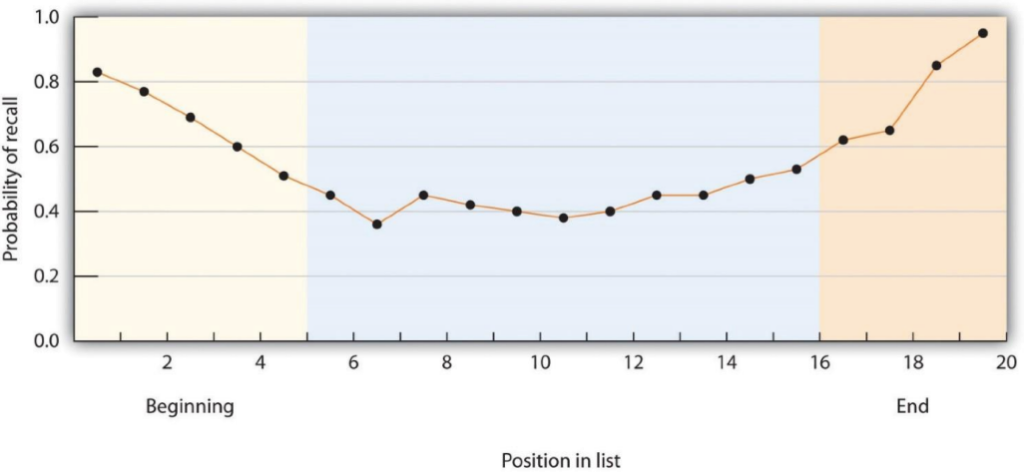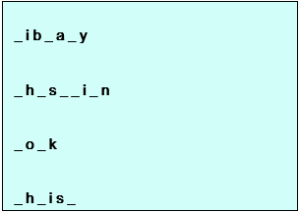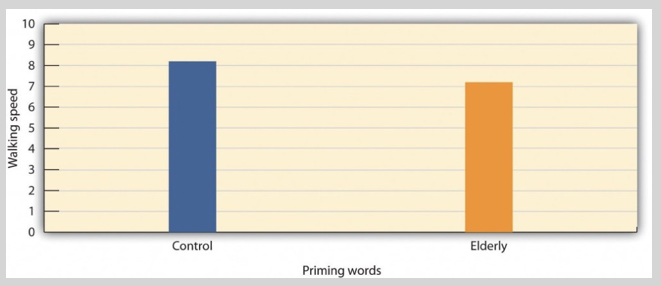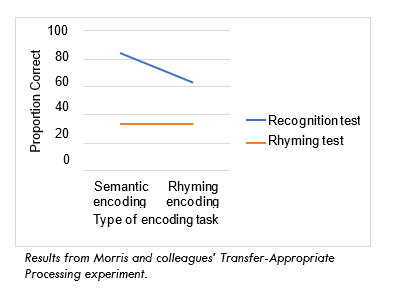CHAPTER 6: LONG-TERM MEMORY

Our memories allow us to do relatively simple things, such as remembering where we parked our car or the name of the current governor of California, but also allow us to form complex memories, such as how to ride a bicycle or to write a computer program. Moreover, our memories define us as individuals — they are our experiences, our relationships, our successes, and our failures. Without our memories, we would not have a life.
WORKING MEMORY VS LONG-TERM MEMORY
As we discussed in the last chapter, working memory is a temporary storage space for information that is being actively stored and manipulated in consciousness. Information that is not rehearsed will be forgotten within 18 to 30 seconds. Long-term memory, on the other hand, is where we store everything from a few moments to the earliest thing we can remember. There is theoretically no upper limit to the amount of information we can store in long-term memory.
THE SERIAL POSITION CURVE
The distinction between working memory and long-term memory can be demonstrated with the serial position curve. When we give people a long list of words one at a time (e.g., on flashcards) and then ask them to recall them, the results look something like those in Figure
1. People are able to retrieve more words that were presented to them at the beginning and the end of the list than they are words that were presented in the middle of the list. This pattern, known as the serial position curve, is caused by two retrieval phenomenon: The primacy effect refers to a tendency to better remember stimuli that are presented early in a list. The recency effect refers to the tendency to better remember stimuli that are presented later in a list.

Figure 1. The serial position curve is the result of both primacy effects and recency effects.
CONCEPT FOCUS: DIFFERENCES BETWEEN BRAINS & COMPUTERS
• In computers, information can be accessed only if one knows the exact location of the memory. In the brain, information can be accessed through spreading activation from closely related concepts.
• The brain operates primarily in parallel, meaning that it is multitasking on many different actions at the same time. Although this is changing as new computers are developed, most computers are primarily serial — they finish one task before they start another.
• In computers, short-term (random-access) memory is a subset of long-term (read- only) memory. In the brain, the processes of short-term memory and long-term memory are distinct.
• In the brain, there is no difference between hardware (the mechanical aspects of the computer) and software (the programs that run on the hardware).
• In the brain, synapses, which operate using an electrochemical process, are much slower but also vastly more complex and useful than the transistors used by computers.
• Computers differentiate memory (e.g., the hard drive) from processing (the central processing unit), but in brains there is no such distinction. In the brain (but not in computers) existing memory is used to interpret and store incoming information, and retrieving information from memory changes the memory itself.
• The brain is self-organizing and self-repairing, but computers are not. If a person suffers a stroke, neural plasticity will help him or her recover. If we drop our laptop and it breaks, it cannot fix itself.
• The brain is significantly bigger than any current computer. The brain is estimated to have 25,000,000,000,000,000 (25 million billion) interactions among axons, dendrites, neurons, and neurotransmitters, and that doesn’t include the approximately 1 trillion glial cells that may also be important for information processing and memory.
Although cognitive psychology began in earnest at about the same time that the electronic computer was first being developed, and although cognitive psychologists have frequently used the computer as a model for understanding how the brain operates, research in cognitive neuroscience has revealed many important differences between brains and computers. The neuroscientist Chris Chatham (2007) provided the list of differences between brains and computers shown here. You might want to check out the website and the responses to it at: http://www.sentientdevelopments.com/2011/05/chris-chatham-10-important-differences.html
There are a number of explanations for primacy and recency effects, but one of them is in terms of the effects of rehearsal on short-term and long-term memory (Baddeley, Eysenck, & Anderson, 2009). Because we can keep the last words that we learned in the presented list in short-term memory by rehearsing them before the memory test begins, they are relatively easily remembered. So the recency effect can be explained in terms of maintenance rehearsal in short-term memory— the most recent words are still available in short-term memory at the time of recall. And the primacy effect may also be due to rehearsal—when we hear the first word in the list we start to rehearse it, making it more likely that it will be moved from short- term to long-term memory. And the same is true for the other words that come early in the list. But for the words in the middle of the list, this rehearsal becomes much harder, making them less likely to be moved to LTM.
STRUCTURE
According to Baddeley’s model, working memory includes a central executive, phonological loop, visuospatial sketchpad, and episodic buffer. What is the structure of long-term memory? As you can see in Figure 2, long-term memory can be divided into two major categories of memory types: explicit memory and implicit memory, which can be further divided into multiple sub-types: semantic, episodic, procedural, priming, and conditioning memory.
EXPLICIT MEMORY
The first form of long-term memory we will discuss is explicit memory. We are measuring explicit memory when we assess memory by asking a person to consciously remember things. Explicit memory refers to knowledge or experiences that can be consciously remembered. There are two types of explicit memory: episodic and semantic. Episodic memory refers to the firsthand experiences that we have had (e.g., recollections of our high school graduation day or of the fantastic dinner we had in New York last year). Semantic memory refers to our knowledge of facts and concepts about the world (e.g., that the absolute value of −90 is greater than the absolute value of 9 and that one definition of the word “affect” is “the experience of feeling or emotion”).

Figure 1. Types of long-term memory.
Explicit memory is assessed using measures in which the individual being tested must consciously attempt to remember the information. A recall memory test is a measure of explicit memory that involves bringing from memory information that has previously been remembered. We rely on our recall memory when we take an essay test, because the test requires us to generate previously remembered information. A multiple-choice test is an example of a recognition memory test, a measure of explicit memory that involves determining whether information has been seen or learned before.
Your own experiences taking tests will probably lead you to agree with the scientific research finding that recall is more difficult than recognition. Recall, such as required on essay tests, involves two steps: first generating an answer and then determining whether it seems to be the correct one. Recognition, as on multiple-choice test, only involves determining which item from a list seems most correct (Haist, Shimamura, & Squire, 1992). Although they involve different processes, recall and recognition memory measures tend to be correlated. Students who do better on a multiple-choice exam will also, by and large, do better on an essay exam (Bridgeman & Morgan, 1996).
A third way of measuring memory is known as relearning (Nelson, 1985). Measures of relearning (or savings) assess how much more quickly information is processed or learned when it is studied again after it has already been learned but then forgotten. If you have taken some French courses in the past, for instance, you might have forgotten most of the vocabulary you learned. But if you were to work on your French again, you’d learn the vocabulary much faster the second time around. Relearning can be a more sensitive measure of memory than either recall or recognition because it allows assessing memory in terms of “how much” or “how fast” rather than simply “correct” versus “incorrect” responses. Relearning also allows us to measure memory for procedures like driving a car or playing a piano piece, as well as memory for facts and figures.
IMPLICIT MEMORY
While explicit memory consists of the things that we can consciously report that we know, implicit memory refers to knowledge that we cannot consciously access. However, implicit memory is nevertheless exceedingly important to us because it has a direct effect on our behavior. Implicit memory refers to the influence of experience on behavior, even if the individual is not aware of those influences. As you can see in Figure 2, “Types of Memory,” there are three general types of implicit memory: procedural memory, classical conditioning effects, and priming.
Procedural memory refers to our often unexplainable knowledge of how to do things. When we walk from one place to another, speak to another person in English, dial a cell phone, or play a video game, we are using procedural memory. Procedural memory allows us to perform complex tasks, even though we may not be able to explain to others how we do them. There is no way to tell someone how to ride a bicycle; a person has to learn by doing it. The idea of implicit memory helps explain how infants are able to learn. The ability to crawl, walk, and talk are procedures, and these skills are easily and efficiently developed while we are children despite the fact that as adults we have no conscious memory of having learned them.
A second type of implicit memory is classical conditioning effects, in which we learn, often without effort or awareness, to associate neutral stimuli (such as a sound or a light) with another stimulus (such as food), which creates a naturally occurring response, such as enjoyment or salivation. The memory for the association is demonstrated when the conditioned stimulus (the sound) begins to create the same response as the unconditioned stimulus (the food) did before the learning.
The final type of implicit memory is known as priming, or changes in behavior as a result of experiences that have happened frequently or recently. Priming refers both to the activation of knowledge (e.g., we can prime the concept of kindness by presenting people with words related to kindness) and to the influence of that activation on behavior (people who are primed with the concept of kindness may act more kindly).
One measure of the influence of priming on implicit memory is the word fragment test, in which a person is asked to fill in missing letters to make words. You can try this yourself: First, try to complete the following word fragments, but work on each one for only three or four seconds. Do any words pop into mind quickly?

Now read the following sentence carefully:
“He got his materials from the shelves, checked them out, and then left the building.” Then try again to make words out of the word fragments.
I think you might find that it is easier to complete fragments 1 and 3 as “library” and “book,” respectively, after you read the sentence than it was before you read it. However, reading the sentence didn’t really help you to complete fragments 2 and 4 as “physician” and “chaise.” This difference in implicit memory probably occurred because as you read the sentence, the concept of “library” (and perhaps “book”) was primed, even though they were never mentioned explicitly. Once a concept is primed it influences our behaviors, for instance, on word fragment tests.
Our everyday behaviors are influenced by priming in a wide variety of situations. Seeing an advertisement for cigarettes may make us start smoking, seeing the flag of our home country may arouse our patriotism, and seeing a student from a rival school may arouse our competitive spirit. And these influences on our behaviors may occur without our being aware of them.
RESEARCH FOCUS: PRIMING OUTSIDE OF AWARENESS INFLUENCES MEMORY
One of the most important characteristics of implicit memories is that they are frequently formed and used automatically, without much effort or awareness on our part. In one demonstration of the automaticity and influence of priming effects, John Bargh and his colleagues (Bargh, Chen, & Burrows, 1996) conducted a study in which they showed undergraduate students lists of five scrambled words, each of which they were to make into a sentence. Furthermore, for half of the research participants, the words were related to stereotypes of the elderly. These participants saw words such as the following: in Victoria retired live people bingo man the forgetful plays
The other half of the research participants also made sentences, but from words that had nothing to do with elderly stereotypes. The purpose of this task was to prime stereotypes of elderly people in memory for some of the participants but not for others.
The experimenters then assessed whether the priming of elderly stereotypes would have any effect on the students’ behavior — and indeed it did. When the research participant had gathered all of his or her belongings, thinking that the experiment was over, the experimenter thanked him or her for participating and gave directions to the closest elevator. Then, without the participants knowing it, the experimenters recorded the amount of time that the participant spent walking from the doorway of the experimental room toward the elevator. As you can see in Figure 3, “Research Results.” participants who had made sentences using words related to elderly stereotypes took on the behaviors of the elderly — they walked significantly more slowly as they left the experimental room.
 Figure 3 Research Results. Bargh, Chen, and Burrows found that priming words associated with the elderly made people walk more slowly (1996).
Figure 3 Research Results. Bargh, Chen, and Burrows found that priming words associated with the elderly made people walk more slowly (1996).
To determine if these priming effects occurred out of the awareness of the participants, Bargh and his colleagues asked still another group of students to complete the priming task and then to indicate whether they thought the words they had used to make the sentences had any relationship to each other, or could possibly have influenced their behavior in any way. These students had no awareness of the possibility that the words might have been related to the elderly or could have influenced their behavior.
ENCODING, RETRIEVAL, AND CONSOLIDATION
Imagine you are able to perfectly study for an exam. You take notes in lecture and read the textbook as the quarter moves along. As you approach the exam, you develop study materials, test yourself on the information, and go to the professor’s office hours to ask about the parts you find the most difficult. The day before the exam, you explain all of the important concepts from class to your best friend. You get a good night’s sleep, and the next morning you find that remembering the important concepts from class feels even easier than it felt the night before. The questions on the exam include bits of information that help you retrieve the concepts that you studied so hard to understand. You leave feeling like your exam performance was a good reflection of the hard work you put in to studying.

Photo by Robert Bye on Unsplash.
In this situation, you were able to successfully encode, retrieve, and consolidate the information you sought to learn. Encoding refers to storing new information in long-term memory. This is the process you engaged in during lecture and studying. Retrieval refers to remembering information from long-term memory. This is what you did when you tested yourself on information and when you took the exam. Consolidation is the stabilization of long-term memories after initial encoding. Consolidation is aided by sleep, which is why you felt even more confident in your knowledge by getting a good night of sleep before the exam. The following sections will discuss the factors that affect encoding, retrieval, and consolidation.
ENCODING
MAINTENANCE REHEARSAL
Maintenance rehearsal is a type of memory rehearsal that is useful in maintaining information in working memory. Because this usually involves repeating information without thinking about its meaning or connecting it to other information, the information is not usually transferred to long term memory. That is, maintenance rehearsal does not usually lead to encoding new long-term memories. An example of maintenance rehearsal would be repeating a phone number mentally, or aloud until the number is entered into the phone to make the call. The number is held in working memory long enough to make the call, but never transferred to long term memory. An hour, or even five minutes after the call, the phone number will no longer be remembered.
DEPTH OF PROCESSING
The levels-of-processing effect, identified by Fergus I. M. Craik and Robert S. Lockhart in 1972, describes memory recall of stimuli as a function of the depth of mental processing at encoding. Deeper levels of analysis produce more elaborate, longer-lasting, and stronger memory traces than shallow levels of analysis. Depth of processing falls on a shallow to deep continuum. Shallow processing (e.g., processing based on phonemic and orthographic components) leads to a fragile memory trace that is susceptible to rapid decay. Conversely, deep processing (e.g., semantic processing) results in a more durable memory trace.
This theory contradicts the multi-store Atkinson-Shiffrin memory model which represents memory strength as being continuously variable, the assumption being that rehearsal always improves long- term memory. They argued that rehearsal that consists simply of repeating previous analyses (maintenance rehearsal) doesn’t enhance long-term memory.

In a study from 1975 (Craik and Tulving) participants were given a list of 60 words. Each word was presented along with three questions. The participant had to answer one of them. Those three questions were in one of three categories. One category of questions was about how the word was presented visually (“Is the word shown in italics?”). This category of questions was meant to promote orthographic processing, or processing related to how the word was written. The second category of questions was
Levels of processing based on evidence from Craik & Tulving. Rogers and colleagues would later add an even deeper level— self-reference. about the phonemic qualities of the word (“Does the word begin with the sound ‘bee’?”). This category was meant to promote phonological processing, or processing related to how the words sound. The third category of questions was presented so that the reader was forced to think about the word within a certain context (“Can you meet one in the street [a friend]”?). This category of questions was meant to promote semantic processing, or processing related to the words’ meaning. The result of this study showed that the more deeply words were processed at encoding, the more likely they were to be remembered later.
Later work by Rogers, Kuiper, & Kirker (1977) expanded the levels-of-processing effect by demonstrating an even deeper level of processing than semantic processing: self-referential processing (e.g., “Does this word describe you?”). This is referred to as the self-reference effect: processing words in terms of their relation to yourself promotes an even higher rate of recall than normal semantic processing.
THE TESTING EFFECT
The testing effect is the finding that encoding into long-term memory is often increased when some of the learning period is devoted to retrieving the to-be-remembered information. The first documented empirical studies on the testing effect were published in 1909 by Edwina E. Abbott. Later, Carrier and Pashler (1992) showed that testing does not just provide an additional practice opportunity, but produces better results than other forms of studying. In their experiment, learners who tested their knowledge during practice later remembered more information than learners who spent the same amount of time studying the complete information. Additionally, a study done by Roediger and Karpicke (2006) showed that students in a repeated-testing condition recalled much more after a week than did students in a repeated-study condition (61% vs. 40%), even though students in the former condition read the passage only 3.4 times and those in the latter condition read it 14.2 times.

RETRIEVAL
Information stored in the memory is retrieved by way of association with other memories. Some memories can not be recalled by simply thinking about them.
Rather, one must think about something associated with it. For example, if someone tries and fails to recollect the memories he had about a vacation he went
Photo albums can be great sources of retrieval cues. Photo by BBH Singapore on Unsplash.
on, and someone mentions the fact that he hired a classic car during this vacation, this may make him remember all sorts of things from that trip, such as what he ate there, where he went and what books he read.
ENCODING SPECIFICITY PRINCIPLE
The encoding specificity principle is the general principle that memory is best when the conditions at encoding match the conditions at retrieval. For example, take the song on the radio: perhaps you heard it while you were at a terrific party, having a great, philosophical conversation with a friend. Thus, the song became part of that whole complex experience. Years later, even though you haven’t thought about that party in ages, when you hear the song on the radio, the whole experience rushes back to you. In general, the encoding specificity principle states that, to the extent a retrieval cue (the song) matches or overlaps the memory trace of an experience (the party, the conversation), it will be effective in evoking the memory. One example of the encoding specificity principle is transfer-appropriate processing, in which memory is best when the type of cognitive processing at recall matches the type of cognitive processing at encoding. This was empirically shown in a study by Morris and associates (1977) using semantic and rhyme tasks. In a standard recognition test, memory was better following semantic processing compared to rhyme processing, as predicted by the levels-of-processing effect. However, in a rhyming recognition test, memory was better for those who engaged in rhyme processing compared to semantic processing. This adds a level of complexity to the levels-of-processing theory: while the levels-of-processing framework generally holds for a normal recognition test, performance on rhyming tests is actually better with phonological than semantic processing at encoding.

Other facets of the encoding specificity principle include context-dependent memory. Context-dependent learning refers to an increase in retrieval when the external situation in which information is learned matches the situation in which it is remembered. Godden and Baddeley (1975) conducted a study to test this idea using scuba divers.
Results from Morris and colleagues’ Transfer-Appropriate Processing experiment.
They asked the divers to learn a list of words either when they were on land or when they were underwater. Then they tested the divers on their memory, either in the same or the opposite situation. The divers’ memory was better when they were tested in the same context in which they had learned the words than when they were tested in the other context. In this instance, the physical context itself provided cues for retrieval.
Whereas context-dependent memory refers to a match in the external situation between learning and remembering, state-dependent memory refers to superior retrieval of memories when the individual is in the same physiological or psychological state as during encoding. Research has found, for instance, that animals that learn a maze while under the influence of one drug tend to remember their learning better when they are tested under the influence of the same drug than when they are tested without the drug (Jackson, Koek, & Colpaert, 1992). Research with humans finds that bilinguals remember better when tested in the same language in which they learned the material (Marian & Kaushanskaya, 2007). Mood states may also produce state-dependent learning. People who learn information when they are in a bad (rather than a good) mood find it easier to recall these memories when they are tested while they are in a bad mood, and vice versa. It is easier to recall unpleasant memories than pleasant ones when we’re sad, and easier to recall pleasant memories than unpleasant ones when we’re happy (Bower, 1981).
CONSOLIDATION
Memory consolidation is a category of processes that stabilize a memory trace after its initial acquisition.
SLEEP CONSOLIDATION
Rapid eye movement (REM) sleep has been thought of to be an important concept in the overnight learning in humans by establishing information in the hippocampal and cortical regions of the brain. REM sleep elicits an increase in neuronal activity following an enriched or novel waking experience, thus increasing neuronal plasticity and therefore playing an essential role in the consolidation of memories. Researchers have noted strong reactivation of the hippocampus during sleep immediately after a learning task. This reactivation led to enhanced performance on the learned task (Wamsley et al., 2010). Researchers following this line of work have come to assume that dreams are a by-product of the reactivation of the brain areas and this can explain why dreams may be unrelated to the information being consolidated. The dream experience itself is not what enhances memory performance but rather it is the reactivation of the neural circuits that causes this.
REFERENCES
Atkinson, R. C., & Shiffrin, R. M. (1968). Human memory: A proposed system and its control processes. In K. Spence (Ed.), The psychology of learning and motivation (Vol. 2). Oxford, England: Academic Press.
Baddeley, A. D., Vallar, G., & Shallice, T. (1990). The development of the concept of working memory: Implications and contributions of neuropsychology. In G. Vallar & T. Shallice (Eds.), Neuropsychological impairments of short-term memory (pp. 54–73). New York, NY: Cambridge University Press.
Bahrick, H. P. (2000). Long-term maintenance of knowledge. In E. Tulving & F. I. M. Craik (Eds.), The Oxford handbook of memory (pp. 347–362). New York, NY: Oxford University Press.
Bargh, J. A., Chen, M., & Burrows, L. (1996). Automaticity of social behavior: Direct effects of trait construct and stereotype activation on action. Journal of Personality & Social Psychology, 71, 230–244.
Bower, G. H. (1981). Mood and memory. American psychologist, 36(2), 129.
Bridgeman, B., & Morgan, R. (1996). Success in college for students with discrepancies between performance on multiple-choice and essay tests. Journal of Educational Psychology, 88(2), 333–340.
Carrier, M., & Pashler, H. (1992). The influence of retrieval on retention. Memory & Cognition, 20(6), 633-642. Cowan, N., Lichty, W., & Grove, T. R. (1990). Properties of memory for unattended spoken syllables. Journal of
Experimental Psychology: Learning, Memory, and Cognition, 16(2), 258–268.
Craik, F. I., & Lockhart, R. S. (1972). Levels of processing: A framework for memory research. Journal of verbal learning and verbal behavior, 11(6), 671-684.
Craik, F. I., & Tulving, E. (1975). Depth of processing and the retention of words in episodic memory. Journal of experimental Psychology: general, 104(3), 268.
Didierjean, A., & Marmèche, E. (2005). Anticipatory representation of visual basketball scenes by novice and expert players. Visual Cognition, 12(2), 265–283.
Haist, F., Shimamura, A. P., & Squire, L. R. (1992). On the relationship between recall and recognition memory.
Journal of Experimental Psychology: Learning, Memory, and Cognition, 18(4), 691–702.
Godden, D. R., & Baddeley, A. D. (1975). Context-dependent memory in two natural environments: On land and underwater. British Journal of psychology, 66(3), 325-331.
Jackson, A., Koek, W., & Colpaert, F. C. (1992). NMDA antagonists make learning and recall state-dependent.
Behavioural pharmacology.
Marian, V., & Kaushanskaya, M. (2007). Language context guides memory content. Psychonomic Bulletin & Review, 14(5), 925-933.
Miller, G. A. (1956). The magical number seven, plus or minus two: Some limits on our capacity for processing information. Psychological Review, 63(2), 81–97.
Mitchell, D. B. (2006). Nonconscious priming after 17 years: Invulnerable implicit memory? Psychological Science, 17(11), 925–928.
Morris, C. D., Bransford, J. D., & Franks, J. J. (1977). Levels of processing versus transfer appropriate processing.
Journal of verbal learning and verbal behavior, 16(5), 519-533.
Nelson, T. O. (1985). Ebbinghaus’s contribution to the measurement of retention: Savings during relearning.
Journal of Experimental Psychology: Learning, Memory, and Cognition, 11(3), 472–478.
Peterson, L., & Peterson, M. J. (1959). Short-term retention of individual verbal items. Journal of Experimental Psychology, 58(3), 193–198.
Roediger III, H. L., & Karpicke, J. D. (2006). Test-enhanced learning: Taking memory tests improves long-term retention. Psychological science, 17(3), 249-255.
Rogers, T. B., Kuiper, N. A., & Kirker, W. S. (1977). Self-reference and the encoding of personal information.
Journal of personality and social psychology, 35(9), 677.
Simon, H. A., & Chase, W. G. (1973). Skill in chess. American Scientist, 61(4), 394–403.
Solomon, M. (1995). Mozart: A life. New York, NY: Harper Perennial.
Sperling, G. (1960). The information available in brief visual presentation. Psychological Monographs, 74(11), 1–29. Unsworth, N., & Engle, R. W. (2007). On the division of short-term and working memory: An examination of simple and complex span and their relation to higher order abilities. Psychological Bulletin, 133(6), 1038–1066.
Wamsley, E. J., Tucker, M., Payne, J. D., Benavides, J. A., & Stickgold, R. (2010). Dreaming of a learning task is associated with enhanced sleep-dependent memory consolidation. Current Biology, 20(9), 850-855.
Wang, Y., Liu, D., & Wang, Y. (2003). Discovering the capacity of human memory. Brain & Mind, 4(2), 189–198.
CHAPTER 6 LICENSE & ATTRIBUTION
Source: Stangor, C. and Walinga, J. (2014). Introduction to Psychology – 1st Canadian Edition. Victoria, B.C.: BCcampus. Retrieved from: https:// opentextbc.ca/introductiontopsychology/
Introduction to Psychology – 1st Canadian Edition by Charles Stangor is licensed under a Creative Commons Attribution-NonCommercial-ShareAlike 4.0 International License.
Changes and additions (c) 2014 Jennifer Walinga, licensed under a Creative Commons Attribution-NonCommercial-ShareAlike 3.0 Unported License.
Condensed from Walinga version; American spellings used; Imperial measurements used; some content adapted to suit course.
Serial position curve information from: Andrade, M., & Walker, N. (n.d.) Cognitive Psychology.
Cognitive Psychology by Mehgan Andrade and Neil Walker is licensed under a Creative Commons Attribution4.0 International License.
Encoding, Retrieval, and Consolidation
Source: The following entries accessed from http:/ www.en.wikipedia.org/ served as sources for this chapter: Memory Rehearsal; Levels-of-processing Effect; Testing Effect; Encoding Specificity Principle; Transfer-Appropriate Processing; Memory Consolidation.
Wikipedia text is licensed under the Creative Commons Attribution- ShareAlike License.
Chapter introduction added. Transitions and images added. Edited for content and clarity throughout.
Some encoding specificity principle information from: Andrade, M., & Walker, N. (n.d.) Cognitive Psychology.
Cognitive Psychology by Mehgan Andrade and Neil Walker is licensed under a Creative Commons Attribution4.0 International License.
Cover photo by Julian Dik on Unsplash.
